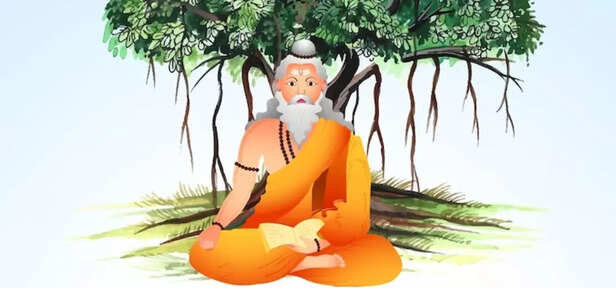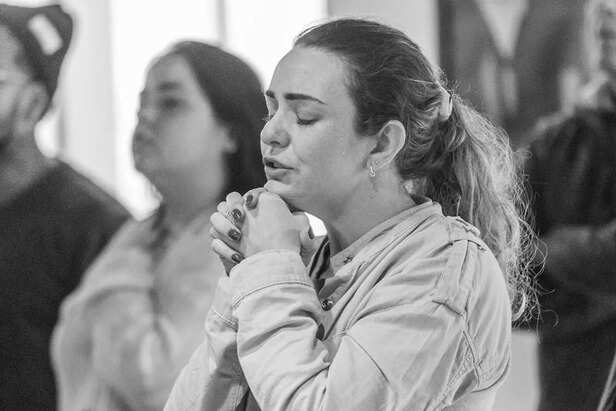Between Myth and Moksha: The Ever-Evolving Forms of Hindu Gods
Nidhi | Feb 24, 2025, 15:12 IST
( Image credit : Times Life Bureau )
Hindu gods have never been static—they have evolved alongside civilization, reflecting changes in culture, philosophy, and human understanding. From nature-worship and Vedic deities to the rise of personal gods in the Bhakti movement, this article explores the transformation of Hindu divinity across time. Through mythology, scriptures, and spiritual shifts, discover how the Hindu pantheon has continuously adapted, shaping and being shaped by those who seek the divine.
"Would Shiva still be the destroyer if he were never woven into the Vedas? Would Krishna be the beloved deity if the Mahabharata hadn’t immortalized his divine play? And what if Rama remained just a local folk hero, unknown to the grand epics?"
Hinduism, often called the world’s oldest living religion, is not a monolith but a fluid, evolving tradition. The gods that dominate its pantheon today were not always as we know them. They were shaped, reshaped, and reinterpreted through centuries of oral folklore, poetic hymns, and philosophical texts. The divine figures we now worship as omnipresent cosmic forces once walked the realm of local legends, tribal deities, and even historical figures. This article explores how Hindu gods transformed from mythic spirits to sacred icons of devotion, moving through folklore, Vedic hymns, Puranic literature, and modern interpretations.
 Long before structured rituals and sacred texts, the earliest forms of worship in the Indian subcontinent were deeply connected to nature. Rivers, mountains, forests, and celestial bodies were considered divine, revered as living entities. The spirits of the land—Yakshas, Nagas, and Matrikas—were worshipped by local communities, each deity embodying the forces of life, fertility, and protection.
Long before structured rituals and sacred texts, the earliest forms of worship in the Indian subcontinent were deeply connected to nature. Rivers, mountains, forests, and celestial bodies were considered divine, revered as living entities. The spirits of the land—Yakshas, Nagas, and Matrikas—were worshipped by local communities, each deity embodying the forces of life, fertility, and protection.
Some of these deities remained at the regional level, while others gradually found their way into the broader Hindu framework, evolving into major gods and goddesses.
 With the arrival of the Vedic period (1500–1200 BCE), Hinduism saw its first structured religious system. The Rig Veda, the oldest known Hindu scripture, introduced a celestial order where gods had defined roles. Indra, the thunder-wielding warrior, was the king of gods; Agni, the fire deity, carried prayers to the heavens; and Varuna upheld cosmic law and morality.
With the arrival of the Vedic period (1500–1200 BCE), Hinduism saw its first structured religious system. The Rig Veda, the oldest known Hindu scripture, introduced a celestial order where gods had defined roles. Indra, the thunder-wielding warrior, was the king of gods; Agni, the fire deity, carried prayers to the heavens; and Varuna upheld cosmic law and morality.
The early Vedic gods were largely anthropomorphic extensions of natural forces. They were powerful yet transactional—humans offered yajnas (sacrificial rituals) in return for blessings, protection, and prosperity.
But as human thought deepened, a shift began. The question was no longer about seeking divine favors but understanding the nature of existence itself.
The Upanishads (800–200 BCE) marked a philosophical revolution in Hindu thought. The focus shifted from external rituals to internal realization. Gods, once seen as separate celestial rulers, were now viewed as manifestations of a single, supreme reality—Brahman.

In this era, the idea of divine plurality coexisted with monism. Instead of simply worshipping gods, seekers aimed for self-realization, recognizing that the divine was not outside but within. This transformation laid the foundation for Advaita Vedanta and other schools of Hindu philosophy that saw gods as symbols of higher consciousness rather than literal beings.
By the time of the Puranas (200–1500 CE), the Hindu pantheon took on the familiar forms we recognize today. The concept of Trimurti—Brahma (the creator), Vishnu (the preserver), and Shiva (the destroyer)—became central, representing different cosmic functions.
 Vishnu’s role expanded significantly, with the introduction of avatars like Rama and Krishna in the Ramayana and Mahabharata, making divine figures more relatable. Shiva transformed from a distant ascetic to a deeply compassionate god, worshipped as the supreme being. Meanwhile, goddesses like Durga, Kali, Lakshmi, and Saraswati emerged as powerful independent forces, symbolizing strength, wisdom, and prosperity.
Vishnu’s role expanded significantly, with the introduction of avatars like Rama and Krishna in the Ramayana and Mahabharata, making divine figures more relatable. Shiva transformed from a distant ascetic to a deeply compassionate god, worshipped as the supreme being. Meanwhile, goddesses like Durga, Kali, Lakshmi, and Saraswati emerged as powerful independent forces, symbolizing strength, wisdom, and prosperity.
This period also saw the integration of folk deities into mainstream Hinduism, merging regional beliefs with established traditions. Hinduism’s adaptability allowed it to remain relevant across ages and geographies.
The Bhakti movement (7th–17th century) brought yet another transformation. No longer confined to temples and scriptures, the divine became a deeply personal experience. Saints like Mirabai, Tulsidas, Kabir, and Chaitanya Mahaprabhu emphasized love and devotion over rituals and caste-based restrictions.

God was no longer just a cosmic ruler but a companion, a guide, and even a beloved friend. Krishna was no longer just a strategist in the Mahabharata but a playful, loving presence in everyday life. Shiva was not just the lord of destruction but the compassionate protector of his devotees. This movement made spirituality accessible to all, regardless of birth or status.
 The arrival of colonial rule brought a new challenge—Hinduism was now being interpreted through the lens of outsiders. Reformers like Swami Vivekananda and Sri Aurobindo redefined Hindu gods in a modern philosophical context, emphasizing their deeper spiritual meanings rather than mythological narratives.
The arrival of colonial rule brought a new challenge—Hinduism was now being interpreted through the lens of outsiders. Reformers like Swami Vivekananda and Sri Aurobindo redefined Hindu gods in a modern philosophical context, emphasizing their deeper spiritual meanings rather than mythological narratives.
In the 20th and 21st centuries, Hindu gods have continued to evolve through art, literature, cinema, and digital media. Television adaptations like Ramayan and Mahabharat in the late 20th century revived devotional interest, while contemporary discussions explore the relevance of Hindu deities in philosophy, psychology, and politics.
Even today, Hinduism remains fluid, allowing its gods to be reinterpreted, rediscovered, and experienced in new ways.
 The evolution of Hindu gods is not merely about changing beliefs; it is a reflection of the evolving human quest for meaning. As societies progressed, gods adapted to fulfill new spiritual, philosophical, and emotional needs. From natural forces to celestial rulers, from abstract cosmic principles to intimate divine companions, the Hindu pantheon has been a living tradition, constantly reshaped by its people.
The evolution of Hindu gods is not merely about changing beliefs; it is a reflection of the evolving human quest for meaning. As societies progressed, gods adapted to fulfill new spiritual, philosophical, and emotional needs. From natural forces to celestial rulers, from abstract cosmic principles to intimate divine companions, the Hindu pantheon has been a living tradition, constantly reshaped by its people.
The question, then, is not whether the gods have changed—but whether we have. In their evolution, we see the reflection of our own journey, from seeking protection to seeking purpose, from external devotion to inner realization.
Hinduism, with its ability to embrace change while staying rooted in its essence, shows us that the divine is not a fixed entity but an eternal presence, ever-evolving, ever-revealing itself to those who seek.
Hinduism, often called the world’s oldest living religion, is not a monolith but a fluid, evolving tradition. The gods that dominate its pantheon today were not always as we know them. They were shaped, reshaped, and reinterpreted through centuries of oral folklore, poetic hymns, and philosophical texts. The divine figures we now worship as omnipresent cosmic forces once walked the realm of local legends, tribal deities, and even historical figures. This article explores how Hindu gods transformed from mythic spirits to sacred icons of devotion, moving through folklore, Vedic hymns, Puranic literature, and modern interpretations.
1. Before the Vedas: The Spirits of Nature

Nature Worship
( Image credit : Pexels )
Some of these deities remained at the regional level, while others gradually found their way into the broader Hindu framework, evolving into major gods and goddesses.
2. The Vedic Age: The Rise of the First Pantheon

Vedas
( Image credit : Freepik )
The early Vedic gods were largely anthropomorphic extensions of natural forces. They were powerful yet transactional—humans offered yajnas (sacrificial rituals) in return for blessings, protection, and prosperity.
But as human thought deepened, a shift began. The question was no longer about seeking divine favors but understanding the nature of existence itself.
3. The Upanishadic Period: From Gods to Cosmic Truths

Vyasa
( Image credit : Times Life Bureau )
In this era, the idea of divine plurality coexisted with monism. Instead of simply worshipping gods, seekers aimed for self-realization, recognizing that the divine was not outside but within. This transformation laid the foundation for Advaita Vedanta and other schools of Hindu philosophy that saw gods as symbols of higher consciousness rather than literal beings.
4. The Puranic Era: The Birth of Personal Gods

Puranas
( Image credit : Times Life Bureau )
This period also saw the integration of folk deities into mainstream Hinduism, merging regional beliefs with established traditions. Hinduism’s adaptability allowed it to remain relevant across ages and geographies.
5. The Bhakti Movement: God Becomes Personal

Praying
( Image credit : Pexels )
God was no longer just a cosmic ruler but a companion, a guide, and even a beloved friend. Krishna was no longer just a strategist in the Mahabharata but a playful, loving presence in everyday life. Shiva was not just the lord of destruction but the compassionate protector of his devotees. This movement made spirituality accessible to all, regardless of birth or status.
6. Colonial and Modern Interpretations: The Gods in a Changing World

Ramayana TV Show
( Image credit : Times Life Bureau )
In the 20th and 21st centuries, Hindu gods have continued to evolve through art, literature, cinema, and digital media. Television adaptations like Ramayan and Mahabharat in the late 20th century revived devotional interest, while contemporary discussions explore the relevance of Hindu deities in philosophy, psychology, and politics.
Even today, Hinduism remains fluid, allowing its gods to be reinterpreted, rediscovered, and experienced in new ways.
Do Gods Change, or Do We?

Hindu Gods
( Image credit : Times Life Bureau )
The question, then, is not whether the gods have changed—but whether we have. In their evolution, we see the reflection of our own journey, from seeking protection to seeking purpose, from external devotion to inner realization.
Hinduism, with its ability to embrace change while staying rooted in its essence, shows us that the divine is not a fixed entity but an eternal presence, ever-evolving, ever-revealing itself to those who seek.
